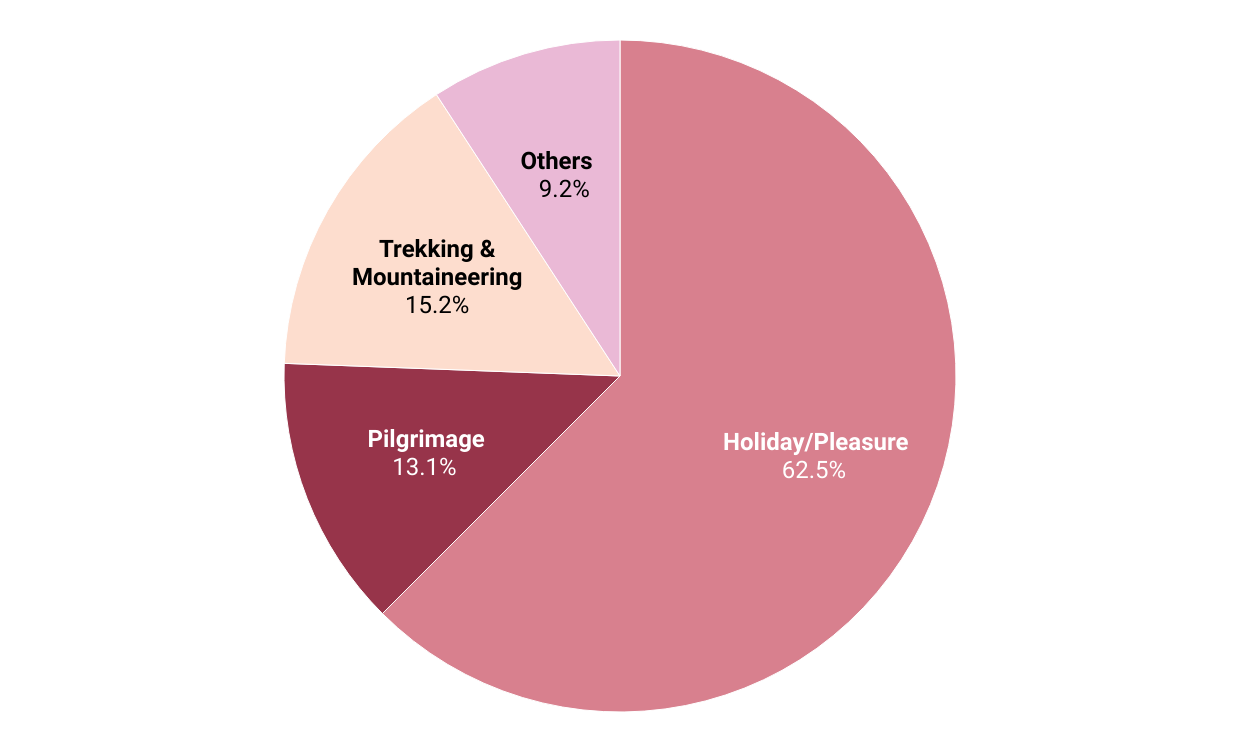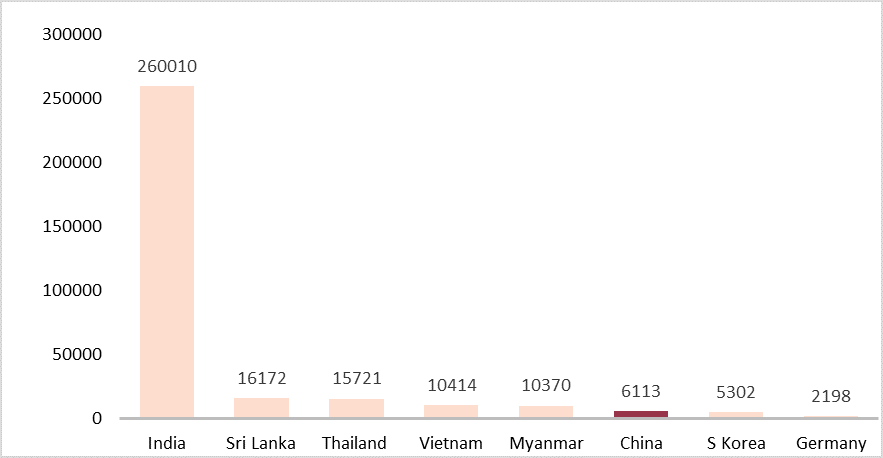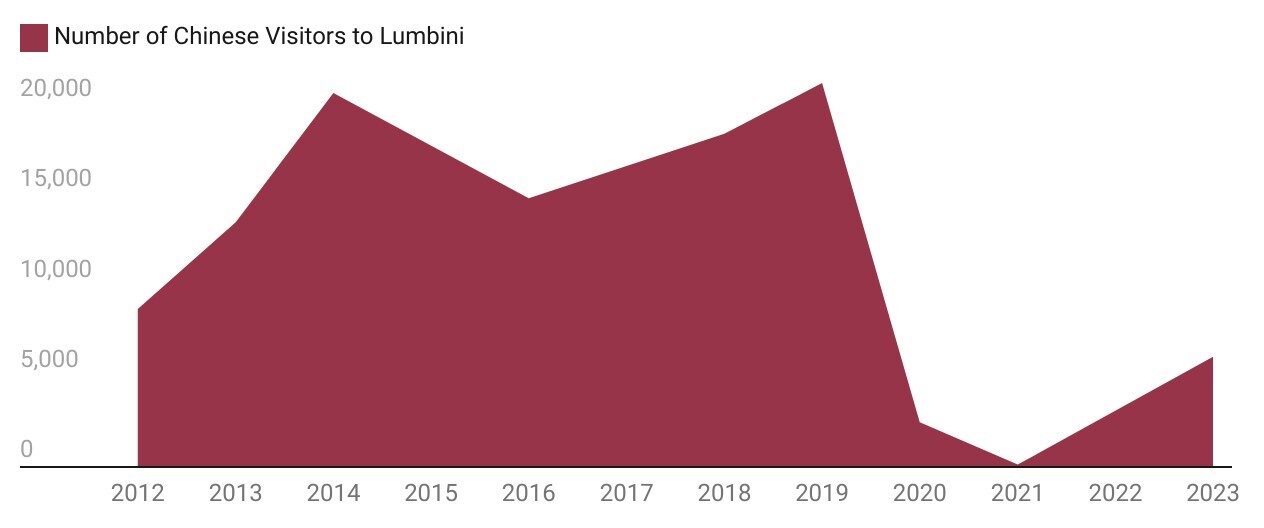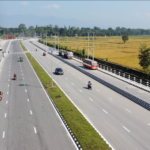Religious tourism is one of humanity’s oldest forms of travel, having shaped human culture for centuries. From ancient pilgrimages, and cultural and historical explorations to modern spiritual retreats, millions have embarked on journeys seeking peace and spiritual fulfillment. Today, religious tourism continues to serve both spiritual and economic purposes worldwide. Globally, over one-third of international tourists travel for religious reasons, making around 450 million trips annually. Furthermore, the market for faith-based tourism is projected to grow at an impressive 9.1% CAGR (compounded annual growth rate) from 2024 to 2034.
These journeys bring together cultures and economies, with Hindus visiting Varanasi and Pashupatinath as acts of devotion, Muslims making Hajj to visit Mecca, Christians gathering at holy sites like Jerusalem and Rome, and Buddhists revering places such as Lumbini in Nepal and Bodhgaya in India. Particularly significant is the growth of Buddhist tourism, driven by the 6.6% of the global population identifying as Buddhists, predominately located in Asia. Nepal, home to the birthplace of Lord Buddha or Lumbini, has become a focal point in this sector. In 2023, 13.1% of Nepal’s tourist arrivals were for religious purposes, reflecting the country’s central role in global religious tourism as shown in Figure 1.
Figure 1. Purpose of Visit to Nepal in 2023
Source: Nepal Tourism Statistics 2023, Ministry of Culture, Tourism and Civil Aviation
Surge in Religious Tourism vis-à-vis Lumbini
Nepal is home to multiple heritage sites with religious significance, and the long list includes Lumbini as well. However, its significance transcends Buddhism, drawing Hindus and seekers of other faiths due to its status as a UNESCO World Heritage Site and World Peace City. Nepal’s tourism sector has been seeing a strong rebound post-COVID across demographics. This is also reflected in the case of Lumbini, which welcomed 343,000 visitors in 2023, substantially up from 82,000 in 2022. The largest segment of these visitors, about 72.90% came from within Nepal, followed by Indian tourists at 29.50%, leveraging their shared border. As shown in Figure 2, other visitors came from countries like Sri Lanka, Thailand, Vietnam, Myanmar, and China, drawn by their strong Buddhist ties.
Chinese tourists have emerged as one of the key segments of Lumbini’s visitors. Before the COVID-19 pandemic, China was Nepal’s second-largest source of tourists, with 169,543 tourists in 2019. This momentum resumed in 2023, as Chinese tourists increased to 60,878, a 6% rise from the previous year. In fact, in 2023, it was the third-largest source-country for tourism, right after India and the United States that year. Furthermore, with China being home to 50% of the global Buddhist population, the historical and cultural ties of Lumbini holds significant potential for religious tourism. This stance was further strengthened by political gestures such as Chinese President Xi Jinping’s 2019 visit to Nepal, highlighting the potential for increased Buddhist travelers from China into Nepal. This marked a milestone in the China-Nepal bilateral relationship. Given their shared 2600-year cultural history, religious tourism from China is likely to grow further.
Figure 2. Number of Tourists of Major Nationalities to Lumbini
Source: Nepal Tourism Statistics 2023, Ministry of Culture, Tourism and Civil Aviation
The 6,113 Chinese visitors to Lumbini in 2023, signals growing engagements between Chinese Buddhists and Nepal’s religious heritage, especially in a post-pandemic context, as highlighted in Figure 3. The sharp increase in incoming Chinese tourists, following a massive dip due to the pandemic, signals a positive trend of growth. This resurgence is supported by several initiatives aimed at boosting Buddhism-based tourism between the two nations. One key development is Beijing’s commitment to promote Nepali tourism domestically, with the announcement of 2025 as “Visit Nepal Year in China.” Such efforts indicate a promising future for Nepal’s tourism sector.
Figure 3. Number of Chinese Visitors to Lumbini over the years
Source: Nepal Tourism Statistics, 2023, Ministry of Culture, Tourism and Civil Aviation
Where We Are: Current Initiatives and Challenges
Recognizing the potential of Lumbini as an economic hub, Nepal has undertaken several projects and initiatives. The Greater Lumbini Buddhist Circuit (GLBC) seeks to connect key Buddhist sites across Nepal, India, and Tibet. This project aims to promote sustainable tourism and longer pilgrimages for spiritual engagement. Additionally, Lumbini has also launched various promotional campaigns, utilizing cultural diplomacy through the Lumbini Development Trust, responsible for managing the region. Lumbini Buddhist University offers Bodhi Chinese language classes to facilitate cultural understanding, enhancing engagement for Chinese tourists. Tailored tour packages now cater to Chinese tourists, featuring guided tours and spiritual experiences like meditation retreats.
The establishment of Gautam Buddha International Airport (GBIA) has the potential to significantly boost tourism by enabling direct flights under China’s “Air Silk Road” initiative. After a period of limited activity, GBIA is set to experience some air traffic, as Thai AirAsia has received approval to operate four weekly flights between Bhairahawa and Bangkok. This marks a positive development for the regional connectivity and economic exchanges.
However, despite these efforts, Lumbini faces critical infrastructure challenges. Master Shi Zhongyong, director of the Chinese Monastery in Lumbini, notes that many visitors from China seek immersive experiences in Buddhist philosophy, which requires extended stays. They seek more than just sightseeing; they wish to connect with the shared history. Unfortunately, inadequate facilities, particularly the lack of large hotels capable of hosting groups of hundreds that Chinese usually visit in, shorten their stay to less than a week. Master Zhongyong emphasized that the current lack of large hotels limits their visits to less than a week, hampering Lumbini’s potential as a spiritual tourism hub.
Moreover, concerns have been raised over the shift from religious devotion to commercialized tourism, with tourists often visiting for entertainment purposes rather than engaging with Lumbini’s spiritual essence. Furthermore, the local communities have not fully benefited from the tourist influx. For instance, the Chinese monastery offers a complete experience for the Buddhist pilgrims (with 500 rooms), therefore overshadowing the local communities’ participation in tourism economy. By addressing gaps like infrastructural deficiencies, finding a balance between spiritualism and entertainment, and enhancing local benefits, Lumbini could transform into a more welcoming destination for large groups of pilgrims.
What Can Be Done: Tourism Enhancement
To fully realize Lumbini’s potential as both a spiritual and economic hub, several strategic initiatives must be prioritized. Firstly, enhancing infrastructure by building larger hotels and improving local amenities is critical to accommodate large tourist groups, particularly from China. Offering Mandarin-speaking guides, immersive spiritual programs, and interactive apps will enrich the visitor experience while maintaining Lumbini’s religious sanctity. Additionally, simplifying visa processes and offering travel incentives could extend visitor stays and boost economic benefits.
From a spiritual engagement perspective, Lumbini could enhance its appeal by organizing workshops on Buddhist teachings, meditation retreats, and wellness programs. Collaborating with neighboring countries to establish a broader Buddhist Circuit would offer pilgrims a richer, more holistic experience. Lesser-known Buddhist sites like Kapilvastu and Tilaurakot could also be promoted to create more comprehensive pilgrimage routes.
Furthermore, leveraging digital platforms such as WeChat and TikTok could elevate Lumbini’s profile among younger audiences, particularly in China. It could be used to promote mindfulness, wellness, and spiritual discovery in an engaging and attractive format. Combining these efforts with eco-friendly practices will ensure Lumbini’s long-term sustainability, preserving its religious and cultural significance for future generations.
Looking Forward: Bridging Tradition and Modernity
Lumbini holds immense potential to serve as both a spiritual sanctuary and a catalyst for economic growth. By addressing current infrastructural gaps, promoting longer stays, and balancing tourism with spiritual integrity, Nepal can transform Lumbini into a thriving destination for religious pilgrims. Many visitors, like myself, often end up merely observing the monuments without engaging in immersive experiences that truly resonate with our spiritual journeys. This lack of interactive activities could diminish our opportunities with the heritage that Lumbini embodies. This holistic approach would not only deepen visitors’ connection to Buddhist heritage but also provide economic benefits to local communities, creating a sustainable model of tourism for the future.
The time is ripe for Nepal to take decisive action in positioning Lumbini as a global hub for religious tourism, ensuring that both spiritual and economic prosperity coexist. Through thoughtful development and cultural preservation, Lumbini can become a cornerstone of both spiritual enlightenment and economic opportunity for generations to come by leveraging its soft power.
This working article serves as part of the ongoing Nepal-China 101 research study being carried out by Nepal Economic Forum.
Bibhuti Kharel graduated with a Master's degree in Business Administration (Project Management) from Kathmandu University. She is keen about development economics, diplomacy as well as energy and sustainability. Currently, she works as a Research Fellow at Nepal Economic Forum (NEF), building on her prior experience as a Project Development Intern in the Investment Board of Nepal.








